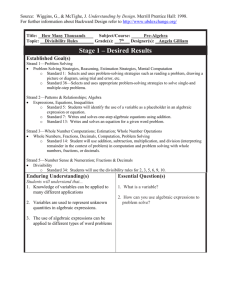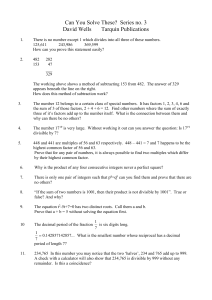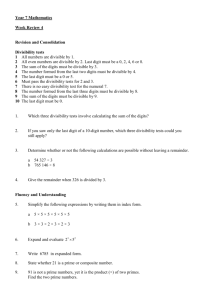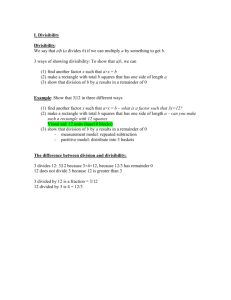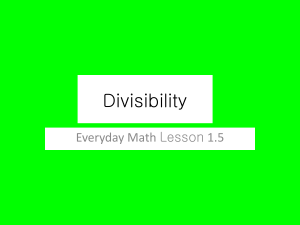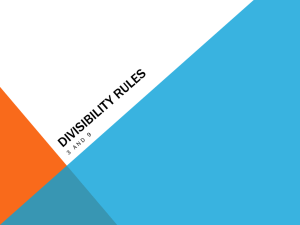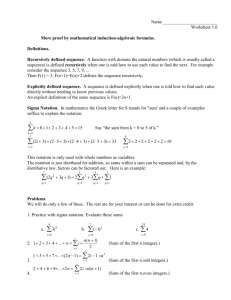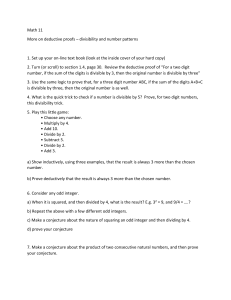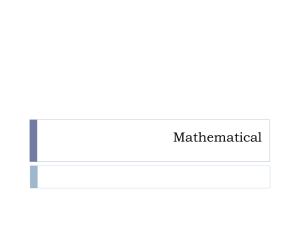Sample Test Problems for Chapter 6
advertisement
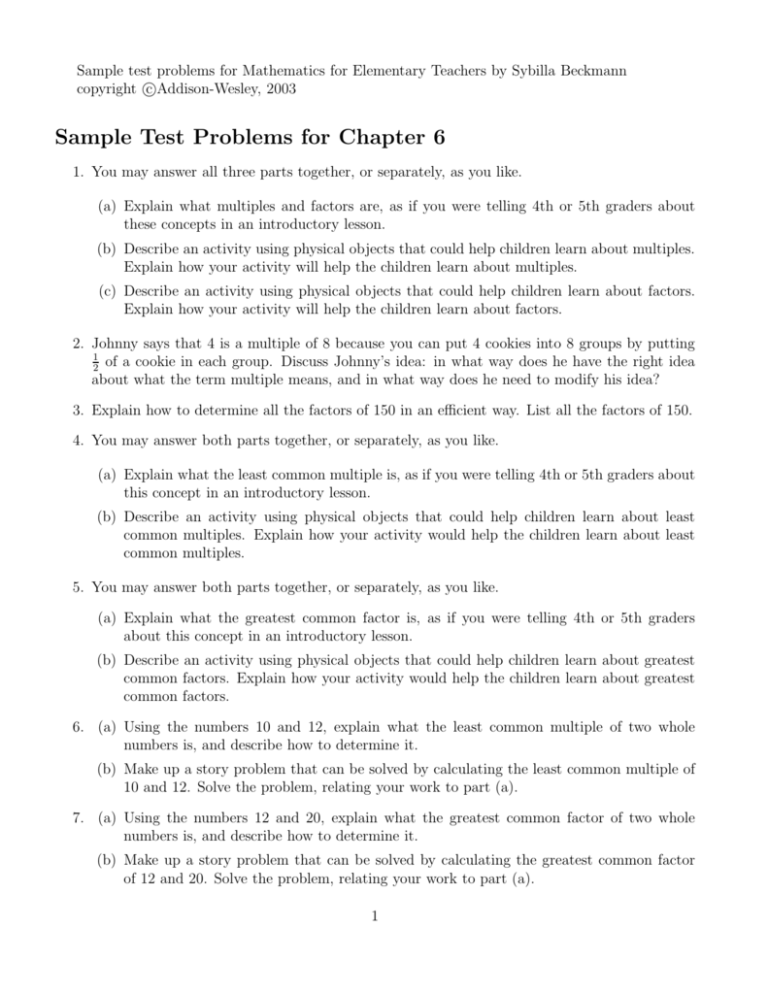
Sample test problems for Mathematics for Elementary Teachers by Sybilla Beckmann c copyright Addison-Wesley, 2003 Sample Test Problems for Chapter 6 1. You may answer all three parts together, or separately, as you like. (a) Explain what multiples and factors are, as if you were telling 4th or 5th graders about these concepts in an introductory lesson. (b) Describe an activity using physical objects that could help children learn about multiples. Explain how your activity will help the children learn about multiples. (c) Describe an activity using physical objects that could help children learn about factors. Explain how your activity will help the children learn about factors. 2. Johnny says that 4 is a multiple of 8 because you can put 4 cookies into 8 groups by putting 1 of a cookie in each group. Discuss Johnny’s idea: in what way does he have the right idea 2 about what the term multiple means, and in what way does he need to modify his idea? 3. Explain how to determine all the factors of 150 in an efficient way. List all the factors of 150. 4. You may answer both parts together, or separately, as you like. (a) Explain what the least common multiple is, as if you were telling 4th or 5th graders about this concept in an introductory lesson. (b) Describe an activity using physical objects that could help children learn about least common multiples. Explain how your activity would help the children learn about least common multiples. 5. You may answer both parts together, or separately, as you like. (a) Explain what the greatest common factor is, as if you were telling 4th or 5th graders about this concept in an introductory lesson. (b) Describe an activity using physical objects that could help children learn about greatest common factors. Explain how your activity would help the children learn about greatest common factors. 6. (a) Using the numbers 10 and 12, explain what the least common multiple of two whole numbers is, and describe how to determine it. (b) Make up a story problem that can be solved by calculating the least common multiple of 10 and 12. Solve the problem, relating your work to part (a). 7. (a) Using the numbers 12 and 20, explain what the greatest common factor of two whole numbers is, and describe how to determine it. (b) Make up a story problem that can be solved by calculating the greatest common factor of 12 and 20. Solve the problem, relating your work to part (a). 1 8. Susie says that she has a quick way to determine the least common multiple of two numbers: you just multiply the numbers. Susie checked it with 3 and 5 and with 4 and 7 and her method worked both times. Is Susie’s method a valid way to determine the least common multiple of two counting numbers? Explain. 9. Explain why the Sieve of Eratosthenes produces a list of prime numbers. 10. The list of prime numbers up to 50 is as follows: 2, 3, 5, 7, 11, 13, 17, 19, 23, 29, 31, 37, 41, 43, 47 (a) Describe how to use the above list of prime numbers to determine whether or not the number 2003 is prime. Determine if 2003 is prime or not. (b) Explain why you do not need any more prime numbers than are shown in the above list in order to determine whether or not 2003 is prime. 11. If you add an odd number and an even number, what kind of number do you get? Explain why your answer is always correct. 12. If you multiply an even number with an odd number, what kind of number do you get? Explain why your answer is always correct. 13. One definition of the term even is the following: a counting number is even if that number of objects can be divided into groups of 2 with none left over. (a) What is another way to define the term even for counting numbers by referring to objects? Why is this definition equivalent to the one above? (b) What is a numerical way to define the term even for counting numbers? Why is this definition equivalent to the one above? (c) Is it possible to extend the definition of even to all integers? If so, is 0 even or not? Explain. Is −5 even or not? Explain. (d) Is it possible to extend the definition of even to all rational numbers (fractions)? Explain why or why not. 14. Let ABC be a three digit whole number with A hundreds, B tens, and C ones. Use the idea of representing ABC with bundled objects to help you explain why ABC is even exactly when C is either 0, 2, 4, 6 or 8. 15. (a) Describe the divisibility test for 3 (the test by which we can quickly and easily tell whether or not a counting number is evenly divisible by 3 without actually dividing the number by 3). Give an example to show how to use this divisibility test. (b) Explain clearly and in detail why the divisibility test for 3 is valid for 3 digit counting numbers ABC (with A hundreds, B tens, and C ones). 2 (c) Let ABC represent a 3-digit counting number (A hundreds, B tens, and C ones). Relate your explanation in part (b) to the following equations: ABC = A · 100 + B · 10 + C = (A · 99 + B · 9) + (A + B + C) = (A · 33 + B · 3) · 3 + (A + B + C) 16. Beth knows the divisibility test for 3. Beth says that she can tell just by looking, and without doing any calculations at all, that the number 999, 888, 777, 666, 555, 444, 333, 222, 111 is evenly divisible by 3. How can Beth do that? Explain why it’s not just a lucky guess on Beth’s part. 17. Sam used his calculator to calculate 123, 123, 123, 123, 123 ÷ 3. Sam’s calculator displayed the answer as 4.1041041041E13 Sam says that because the calculator’s answer is not a whole number, therefore the number 123, 123, 123, 123 is not evenly divisible by 3. Is Sam right? Why or why not? How do you reconcile your answer with Sam’s calculator’s display? 18. (a) Describe a divisibility test for 4, in other words describe an easy way to check whether or not a counting number is evenly divisible by 4 without actually dividing the number by 4. Give an example to show how to use this divisibility test. (b) Explain clearly and in detail why the divisibility test for 4 is a valid way to determine if a whole number is evenly divisible by 4. 19. (a) Describe a divisibility test for 5, in other words describe an easy way to check whether or not a counting number is evenly divisible by 5 without actually dividing the number by 5. Give an example to show how to use this divisibility test. (b) Explain clearly and in detail why the divisibility test for 5 is a valid way to determine if a whole number is evenly divisible by 5. 20. (a) Describe a divisibility test for 9, in other words describe an easy way to check whether or not a counting number is evenly divisible by 9 without actually dividing the number by 9. Give an example to show how to use this divisibility test. (b) Explain clearly and in detail why the divisibility test for 9 is valid for 3 digit counting numbers ABC (with A hundreds, B tens, and C ones). 3 (c) Let ABC represent a 3-digit counting number (A hundreds, B tens, and C ones). Relate your explanation in part (b) to the following equations: ABC = A · 100 + B · 10 + C = (A · 99 + B · 9) + (A + B + C) = (A · 11 + B · 1) · 9 + (A + B + C) 21. (a) Is it true that a whole number is evenly divisible by 6 exactly when the sum of its digits is divisible by 6? (b) If your answer in part (a) is no, then what is an easy way to determine if a counting number is evenly divisible by 6 other than actually dividing the number by 6? (Hint: 6 = 2 × 3.) (c) Check if the number 111, 222, 333, 444, 555, 666, 777, 888, 999, 000 is evenly divisible by 6 without actually dividing the number by 6. 22. Write 0.134 as a fraction of whole numbers, explaining your reasoning. 23. Show how to use long division to calculate the decimal representation of of this decimal representation. 4 . 37 Describe the nature 24. Suppose you have two decimals and that each one is either repeating or terminating. Is it possible that the product of these two decimals could be neither repeating nor terminating? Explain your answer. 25. Tai used a calculator to solve an arithmetic problem. The calculator gave Tai the answer 0.019607843137. Without any further information, is it possible to tell if the answer to Tai’s arithmetic problem can be written as a fraction of whole numbers? Explain. 26. Without actually determining the decimal representation of sentation must either terminate or repeat. 5 , 31 explain why its decimal repre- 27. Give an example of an irrational number. 28. Explain why 0.9 = 1. 29. Describe the decimal numbers that are the decimal representations of fractions of whole numbers. 4
